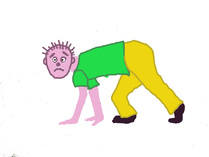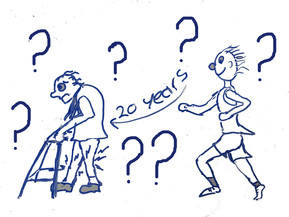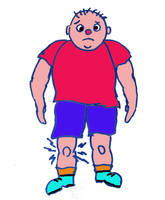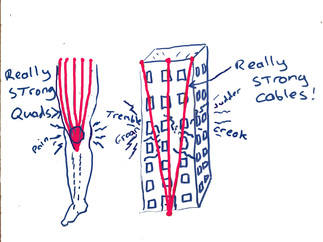Knee Myths
Five Knee Myths
The knee is a weight bearing joint, designed perfectly by nature to bear our weight whilst standing walking running or jumping. I don’t believe nature makes mistakes when it comes to our design.
Myth 1
Our knees ‘wear out’ because we are not designed to walk upright.
When used correctly the human machine is designed perfectly in every way, to walk upright. If you need more proof of this, then watch the Olympics, or ‘people are amazing’ on you tube.

Myth 2
Knees ‘wear out’ because we jog to far, or run to far, or because we’re too heavy.
We are not machines in the sense of metal parts moving and grinding against each other gradually wearing away creating a finite life span. Humans are biological self-regulating machines. As we wear, so we repair. In normal structurally efficient use a human knee can literally run walk and jump for thousands of miles in a lifetime.

However, if your body is out of balance, and inappropriate muscle tensions are causing you to lean forward, backwards or sideways, then you may well begin a process of wear that outpaces your body’s ability to repair. If the muscles in your hip are not allowing healthy full rotation of the hip joint, or worse causing it to turn one way or the other as you are walking, then the knee will have a rotational force placed upon it every time you take a step. This is on top of the normal force caused by walking, which the knee is designed for. Similarly, if the shock absorbing arches of your feet are not being utilised effectively, then the impact of each step is taken up by your knee cartilage, (correctly known as the meniscus) leading to excessive stress. The same goes for poor running technique and poor footwear.
If you are carrying excess weight, it makes some sense that your knees might be suffering some excess stress. But the reality is overweight people tend to do less anyway, so the wear isn’t there. Someone who is five stone overweight is unlikely to be running a marathon, and if they did, well they wouldn’t be fat for very long would they? So the likelihood of having knee pain because you are overweight is very, slim... ahem. Also the vast majority of people I have treated for knee pain were and are slim. How is this explained? If someone is overweight the cause of their knee pain must be due to their weight, but if you’re slim it must be due to something else? Also don’t forget that an overweight person will also be stronger. If you carry excess weight, you must adapt to that weight and get stronger. Soldiers who carry 100 pound back packs don’t necessarily get knee pain, but they certainly get stronger!

Myth 3
If you damage your knee, apply ice.
For decades ice has been the treatment of choice for painful inflammatory conditions, any suggestion of an alternative approach gets the same response Galileo got for daring to suggest the Earth was not the centre of the Universe.
The fact is, ice is actually very poor at stopping inflammation and very good at stopping healing. I direct you to this article which is one of many reports of cryotherapy studies that confirm this. BAD ICE
A talented acupuncturist once told me that the Chinese have one use for ice, and that is to preserve dead things!
If you have a swollen joint, use effleurage ( a massage stroke) and oil to move the fluid out of the tissues towards the heart. Start very lightly with plenty of oil, use broad flat strokes with the palm of your hand working towards the heart, and gently increase the pressure as it becomes more bearable. Do this as often as you like during the acute stage of any swelling. The rest of the “R.I.C.E.” protocol is fine, so Rest, but cut out the Ice and use Efflurage instead. (above). Use gentle Compression bandages and, then Elevate the joint, above heart level ideally, to enable best recovery from acute irritation and inflammation.
Myth 4
You should never flex your knee beyond 90 degrees especially when lifting weight.
This is what’s known as confusing correlation with causation.
With thinking along the lines that because knee pain started while running, it must be because of the running that knee pain started. This is as flawed as thinking that because sufferer was breathing heavily at the time the pain started, then the cause of the knee pain is heavy breathing.
The point is that if the structure of your body is out of balance, leading to dysfunctional use of the knee, the wear may outpace the repair. The problem has been building for ages, maybe months, maybe even years, and the final factor that tips the knee over the edge and into pain is squatting beyond a 90 degree knee bend to lift something. This is the proverbial straw that breaks the camel’s back. The knee “goes”, not because full squats are bad but because the knee was on the verge of going anyway.
The fact is half the people on the planet spend three quarters of their life in a full squat, they rest, cook and socialise on their haunches. An interesting point to consider is that these people have a much lower incident of knee pain than those of us in the West who rarely bend our knees beyond 90 degrees and couldn’t squat (in most cases) for more than a few minutes.
Myth 5
You can protect and/or rehabilitate your knee by strengthening your quadriceps (front thigh muscles)
All you have to do to help your painful knee recover is “strengthen” your quads. This theory disregards the laws of physics as well as demonstrating a poor understanding of anatomy and physiology. There are so many flaws in this theory it’s difficult to know where to start debunking it.
Let’s start with the laws of physics. The quads are the huge group of 4 powerful muscles on the FRONT of the upper leg. They have a tiny attachment at the top of the shin bone. Even if we disregard how a muscle works and what its function is, to suggest that you can support your knee by strengthening your quads is like suggesting you can save an unstable collapsing building by putting really strong cables down one side of the building.
A structural engineer would laugh at that approach and rightly so.
How on earth are those “really Strong” cables going to stop the building from :-
1) Collapsing downwards?
2) Falling to the left?
3) Falling to the right?
4) Twisting either way?
5) Collapsing forward?
6) Breaking in half?

Let’s take anatomy. Where is the quadriceps muscle? And what does it do? Ok we’ve established it’s on the front of the upper leg. It begins at the pelvis and the top of the thigh bone. All four parts attach to one point on the top of the shin bone. So this is an important muscle because it crosses the knee joint . But so do the hamstrings on the back of the thigh, so do the calf muscles on the back of the lower leg, so does the Sartorius muscle going diagonally across the thigh to attach to the pelvis, so does the gracillis on the inside of the thigh, and the illio tibial band on the outside of the thigh. Have you ever been told to strengthen any of those to help protect your knee?
The next aspect of anatomy is what ALL muscles do, what they are designed to do and can ONLY do. Even if you did consider strengthening muscles on all sides of the knee which at least makes some sense, it wouldn’t work because muscles can only MOVE joints. They can’t, don’t and won’t ever support a joint. So the stronger your muscle, the more strongly you can MOVE the joint that the muscle works across.
Are we suggesting that people with strong muscles won’t get knee pain?? Probably the majority of people I treat with knee problems are athletes, from all fields, dancers, weightlifters, runners, cyclists. These are people whose muscles are already stronger than the average persons.
There is one thing that supports a joint, and that’s ligaments. Ligaments can’t be strengthened – full stop.
Physiology.
Physiology is the study of how things work in the body, often at a cellular level but it includes systemic factors as well. The body is an absolute master of adaptation and it’s a master of minimalism.
What this boils down to is the fact that the body adapts to the stresses imposed upon it. If you begin endurance training you will tend to loose muscle mass, muscles are heavy! And they use truckloads of energy just to support themselves. Your body does not want to be dragging heavy muscles along for 25 miles. Anyone noticed the difference between Mo Farah and Usain Bolt? Explosive bursts of short term energy require massive muscle power, but massive muscles can only be supplied with energy for a short time. Endurance requires the ability to continue burning energy without burning out. So the body adapts. Currently your muscles are strong enough to do whatever it is you do on a regular basis.
If you start doing squats or knee extension exercises to a level that is so hard you literally tear the muscle fibres, and you do it on a regular basis, your thighs will adapt and get stronger. But guess what, if you stop, your body will adapt to your new level of activity and your muscles will get smaller and weaker, quickly returning to their former strength and size.
Your body has no use for fuel guzzling heavy muscle that’s not being used, so it quickly, sometimes depressingly quickly, returns your muscles back to their normal size and strength. So to maintain whatever strength gains you make, using whatever exercise you use, you will have to continue for the rest of your life.
You also need to question why your good knee is ok, was that stronger to start with? Why hasn’t your mum got painful knees? She must have stronger thigh muscles than you!